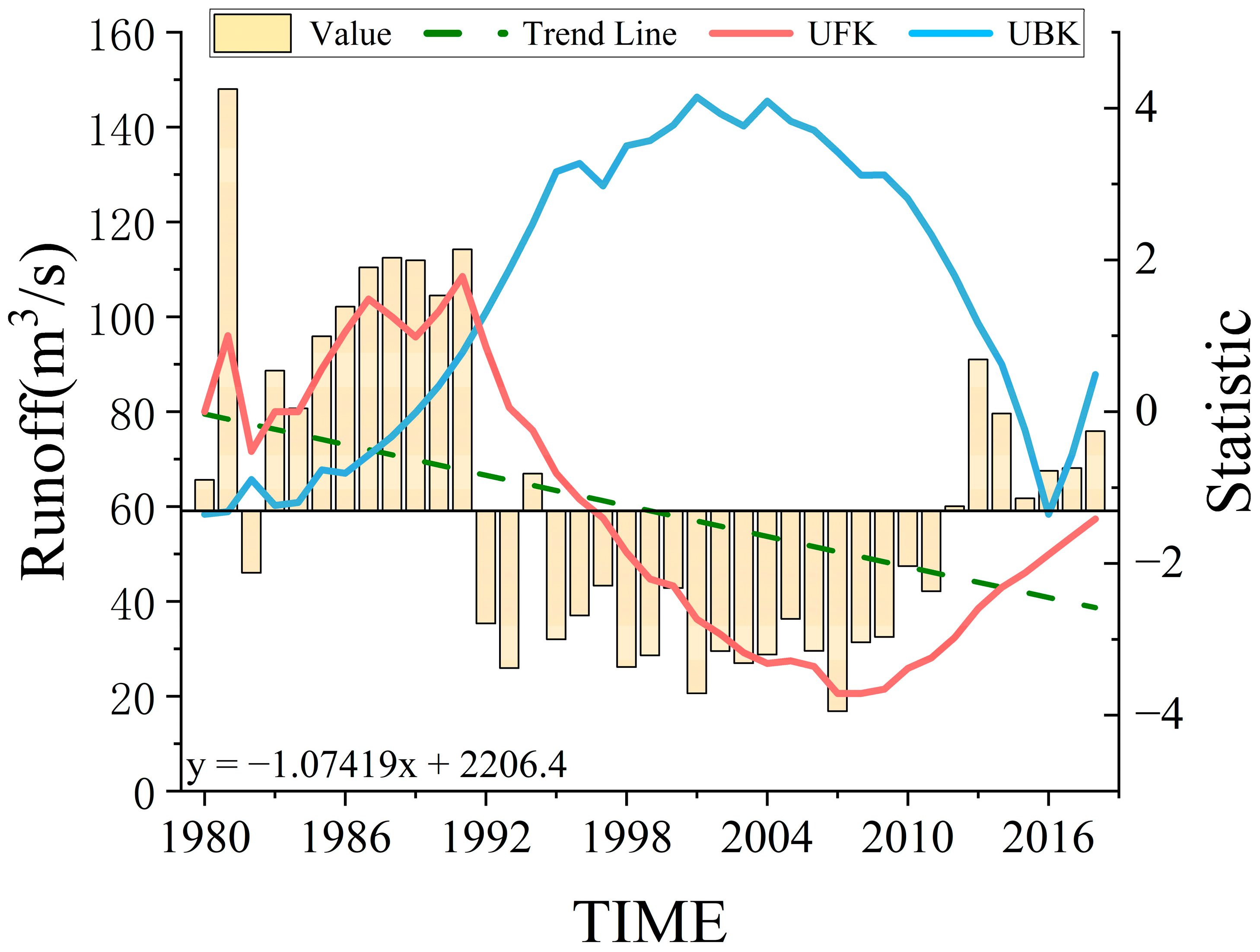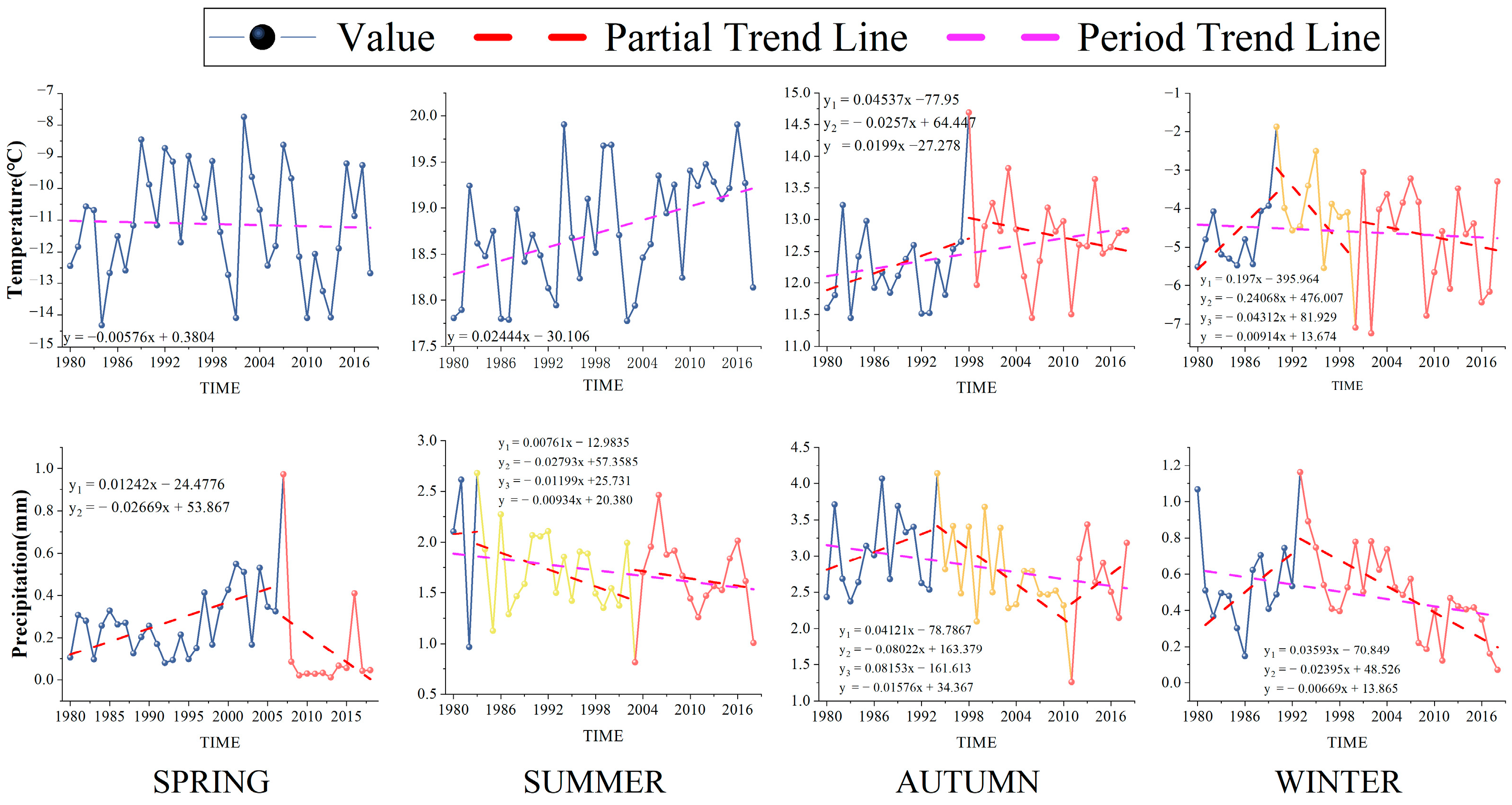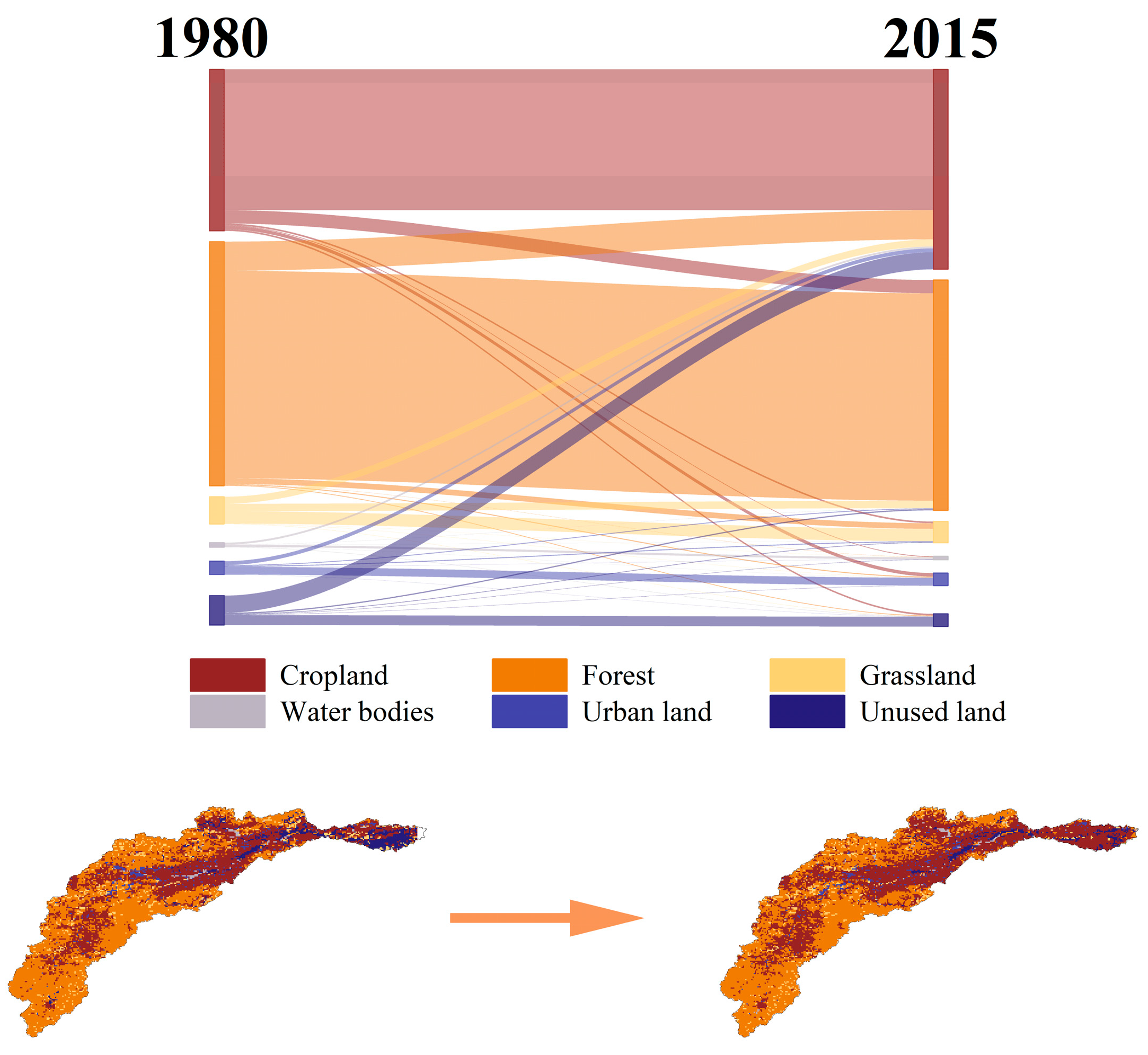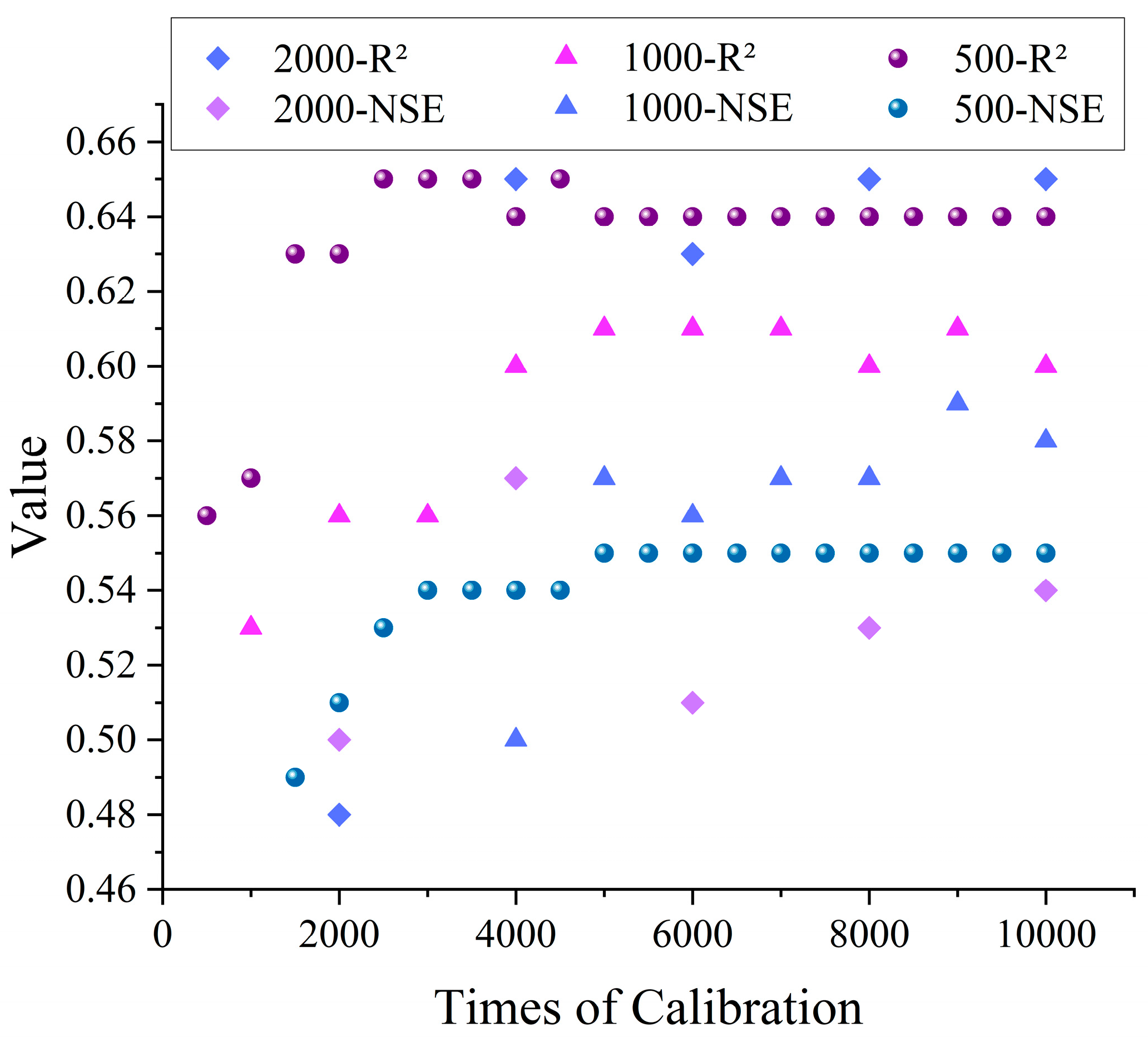Effects of Climate Change and Human Activities on the Flow of the Muling River
Abstract
1. Introduction
Study Area
2. Materials and Methods
2.1. Data Sources
2.2. SWAT Model
2.3. Mann–Kendall Test
2.4. Calculation of Contribution Rate
3. Results and Analysis
3.1. Data Analysis
3.1.1. Meteorological Data
3.1.2. Precipitation Data
3.1.3. Analysis of Runoff Change
3.2. Effects of Climate Change and Precipitation Change on Runoff
3.3. Influence of Human Activities on Runoff
3.4. Influence of SWAT-CUP Parameters on Simulation
3.4.1. Influence of Different Single Calibration Times on Simulation
3.4.2. Influence of Parameter Sensitivity on Simulation
4. Discussion
4.1. Influence of Climate Change on Runoff
4.2. Influence of Land Use Types on Runoff
4.3. Influence of SWAT-CUP on Runoff
4.4. Future Work
5. Conclusions
- The SWAT model has good applicability in the Muling River basin. The runoff of the Muling River basin showed a significant decreasing trend from 1980 to 2018, and the abrupt change year was 1992.
- Under the hydrological conditions of the Muling River basin, the response of river runoff to human activities is more pronounced than that to climate change. Among the subdivisions of climate change, precipitation changes have a greater impact on runoff than temperature changes. In the classification of human activities, reservoirs exhibit the most significant impact on runoff changes, while different types of land use changes also lead to varying effects on runoff: an increase in grassland and forest land will reduce runoff, whereas an increase in construction land and cultivated land will increase runoff. At different time scales, the influence of precipitation on runoff is more pronounced at the seasonal scale than at the annual scale. Therefore, when managing the water resources in the Muling River basin, in order to prevent the river from affecting the production and life within the basin, special attention should be paid to the impact of short-term precipitation on the basin, and the influence of different land use types within the basin on the runoff volume should also be taken into consideration.
- Within a specific range of parameter quantities, different numbers of calibration trials yield distinct effects. For example, in this experiment, a single calibration count of 500 times produced the optimal overall performance, and different types of parameters also exhibited discernible patterns during the overall calibration process. Additionally, when targeting a specific watershed, selecting different parameters can lead to varied impacts on the calibration results.
Author Contributions
Funding
Data Availability Statement
Conflicts of Interest
References
- IPCC. Climate Change 2022: Mitigation of Climate Change; IPCC: Geneve, Switzerland, 2022. [Google Scholar]
- Liu, C.; Chao, Q.; Wang, S.; Liu, Z. Advances in hydrologic cycle research in hydrometeorology. Adv. Clim. Change Res. 2023, 19, 1–10. [Google Scholar]
- Lian, Y.; Sun, M.; Wang, J.; Luan, Q.; Jiao, M.; Zhao, X.; Gao, X. Quantitative impacts of climate change and human activities on the runoff evolution process in the Yanhe River Basin. Phys. Chem. Earth 2021, 122, 102998. [Google Scholar] [CrossRef]
- Villoria, N. Consequences of agricultural total factor productivity growth for the sustainability of global farming: Accounting for direct and indirect land use effects. Environ. Res. Lett. 2019, 14, 125002. [Google Scholar] [CrossRef]
- Pei, Y.; Liu, J.; Wang, J.; Mei, C.; Dong, L.; Wang, H. Effects of urbanization on extreme precipitation based on Weather Research and Forecasting model: A case study of heavy rainfall in Beijing. J. Hydrol. Reg. Stud. 2024, 56, 102078. [Google Scholar] [CrossRef]
- Yang, L.; Feng, Q.; Yin, Z.; Wen, X.; Si, J.; Li, C.; Deo, R.C. Identifying separate impacts of climate and land use/cover change on hydrological processes in upper stream of Heihe River, Northwest China. Hydrol. Process. 2017, 31, 1100–1112. [Google Scholar] [CrossRef]
- Guo, J.; Su, X.; Singh, V.P.; Jin, J. Impacts of Climate and Land Use/Cover Change on Streamflow Using SWAT and a Separation Method for the Xiying River Basin in Northwestern China. Water 2016, 8, 192. [Google Scholar] [CrossRef]
- Ma, Y.; Jiang, Y.; Wang, F.; Lu, S.; Liu, Y. Characterization and attribution of runoff changes in the upper Niyang River basin. South-North Water Divers. Water Resour. Sci. Technol. 2025, 1–10. [Google Scholar]
- Yi, L.; Chen, F.; Han, J.; Liu, X.; Yang, J.; Zhou, Z.; Lu, X.; Ma, Z.; Wei, H.; Han, F. Distributed hydrological simulation and runoff prediction of the upper Golmud River based on SWAT model. Salt Lake Res. 2024, 32, 1–10. [Google Scholar] [CrossRef]
- Wang, Z.; Gu, H.; Wang, X.; Dai, B.; Zhang, H.; Fu, X.; Yu, Z. Modeling of water-sediment processes and their response to vegetation cover and climate change in the Lhasa River Basin. Hydrology 2023, 43, 91–96. [Google Scholar] [CrossRef]
- Qi, X.; Yang, Y.; Han, C.; Li, J.; Li, J.; Liu, Z.; Li, M.; Zhang, X.; Bao, W.; Lu, S.; et al. Impacts of climate change on surface runoff in the Yangtze River source area. J. Nanjing Norm. Univ. 2022, 45, 81–90. [Google Scholar]
- He, X.; Miao, Z.; Tian, J.; Yang, L.; Zhang, Z.; Zhu, B. Multi-modeling based on CMIP 6. Multi-model prediction of temperature, precipitation and runoff in the Yangtze River Basin based on CMIP 6. J. Nanjing For. Univ. 2024, 48, 1–8. [Google Scholar]
- Yang, Y.; Ma, L.; Li, S.; Gao, Y.; Li, M.; Liu, Z.; Si, J.; Lu, S.; Chen, Y.; Li, Z.; et al. Construction of SWAT hydrological model database for the Yangtze River source area and model calibration and validation. J. Anhui Univ. 2022, 46, 76–84. [Google Scholar]
- Zheng, P.; Chen, Y.; Wang, H.; Yang, Y. Impacts of climate change on extreme runoff in the Tien Shan region—A case study of the Kaidu River. J. Irrig. Drain. 2024, 43, 105–112. [Google Scholar] [CrossRef]
- Jiang, N.; Ni, F.Q.; Deng, Y.; Xiang, J.; Wu, M.Y.; Kang, W.D.; Yue, Z.Y. CMIP6-based runoff prediction in the MinTuo River Basin. J. Water Ecol. 2024, 1–13. [Google Scholar] [CrossRef]
- Guo, X.; Jia, Y.; Fan, L.; Wang, G. Impacts of climate change and human activities on watershed runoff and its intra-annual distribution. J. Water Resour. Transp. Eng. 2024, 1–12. [Google Scholar]
- Wang, F.; Hong, L.; Ma, T.; Tunyaz, J.; Xiong, J. Changes of runoff in Nomin River Basin under climate change conditions based on SWAT model. Soil Water Conserv. Res. 2023, 30, 67–77. [Google Scholar] [CrossRef]
- Zhou, F.; Li, H.; Liu, R. Simulation of runoff in the Qingshui River Basin under future climate change and land use scenarios. Hydropower Energy Sci. 2023, 41, 11–14+102. [Google Scholar] [CrossRef]
- Wang, R.; Dai, C.; Yu, C.; Chen, L. Hydrological response of runoff to climate change in the Huma River Basin based on the SWAT model. Hydropower Energy Sci. 2023, 41, 27–30. [Google Scholar] [CrossRef]
- Deng, R.; Zhnag, Z.; Chen, Y. Response of surface runoff to land use change in the lower Jialing River Basin. Soil Water Conserv. Res. 2019, 26, 141–147. [Google Scholar] [CrossRef]
- Wang, H.X.; Liu, J.H.; Zhao, Y.I.; Guo, L. Water-sand changes and attribution analysis in the lower Yellow River. People’s Yellow River. 2021, 43, 24–29+71. [Google Scholar]
- Liu, W.; Li, P.; Qiao, Z.; Xie, Z.; Tang, L. Impacts of land use change on water supply and flood regulation services in a river basin. J. Hydropower Gener. 2025, 44, 77–97. [Google Scholar]
- Liu, W.; Wu, J.; Xu, F.; Mu, D.; Zhang, P. Modeling the effects of land use/land cover changes on river runoff using SWAT models: A case study of the Danjiang River source area, China. Environ. Res. 2024, 242, 117810. [Google Scholar] [CrossRef]
- Li, Y.; He, H.; Jin, S.; Wu, Z.; Li, Y. Attribution analysis of runoff change in Luo River based on improved hydrological simulation. China Rural. Water Conserv. Hydropower 2024, 6, 56–63. [Google Scholar]
- Lu, Z.; Zhang, J.; Li, C.; Dong, Z.; Lei, G.; Yu, Z. Effects of land use change on runoff depth in the Songnen Plain, China. Sci. Rep. 2024, 14, 24464. [Google Scholar] [CrossRef]
- Huang, T.; Liu, Y.; Jia, Z.; Zou, J.; Xiao, P. Applicability of attribution methods for identifying runoff changes in changing environments. Sci. Rep. 2024, 14, 26100. [Google Scholar] [CrossRef]
- Sreedevi, S.; Eldho, T.I.; Jayasankar, T. Physically-based distributed modelling of the hydrology and soil erosion under changes in landuse and climate of a humid tropical river basin. CATENA 2022, 217, 106427. [Google Scholar] [CrossRef]
- Yan, Y.; Ding, H.; Zhang, J.; Gao, Y. Evolution and attribution of runoff in the west-flowing Songhua River Basin. Pearl River 2025, 46, 10–20. [Google Scholar]
- Zheng, D.; Wang, Z. Attribution analysis of runoff in the upper reaches of the Hun River based on Budyko theory. Jilin Water Resour. 2025, 5, 33–38. [Google Scholar] [CrossRef]
- Lv, S.; Tang, Y.; Tang, Q.; Li, H.; Xiao, H.; Xie, D. Impacts of climate change on annual and seasonal runoff in the Lena River Basin. J. Geogr. Sci. 2024, 79, 2811–2829. [Google Scholar]
- Zhao, Y.; Sun, Y.; Huang, X. A study of runoff changes in the upper Tangwang River basin based on the CMIP-6 climate model. Pearl River. 2025, 46, 109–117. [Google Scholar]
- Cao, Z.Y. Characteristics of intra-annual distribution of runoff in the upper Muleng River Basin. Hydropower Energy Sci. 2019, 37, 21–25. [Google Scholar] [CrossRef]
- Zare, M.; Azam, S.; Sauchyn, D. A Modified SWAT Model to Simulate Soil Water Content and Soil Temperature in Cold Regions: A Case Study of the South Saskatchewan River Basin in Canada. Sustainability 2022, 14, 10804. [Google Scholar] [CrossRef]
- Valencia, S.; Villegas, J.C.; Hoyos, N.; Duque-Villegas, M.; Salazar, J.F. Streamflow response to land use/land cover change in the tropical Andes using multiple SWAT model variants. J. Hydrol.-Reg. Stud. 2024, 54, 101888. [Google Scholar] [CrossRef]
- Tilahun, Z.A.; Bizuneh, Y.K.; Mekonnen, A.G. The combined effects of LULC changes and climate change on hydrological processes of Gilgel Gibe catchment, southwest Ethiopia. Cogent Soc. Sci. 2025, 11, 2473644. [Google Scholar] [CrossRef]
- Yang, W.; Liang, Z.; Pei, Z.; Lei, J.; Yang, X. Simulation and analysis of water environment capacity in alpine watershed based on SWAT-WASP: A case study of Luqu in Taohe River. China Environ. Sci. 2025, 1–15. [Google Scholar] [CrossRef]
- Zhao, J.; Zhang, N.; Liu, Z.; Zhang, Q.; Shang, C. SWAT model applications: From hydrological processes to ecosystem services. Sci. Total Environ. 2024, 931, 172605. [Google Scholar] [CrossRef]
- Jitan, Y.; Li, H.; Li, X. Rates of spatial heterogeneity of snowmelt runoff in the SWAT model in the cold region of Northeast China: A case study in the Baishan Basin. J. Jilin Univ. 2023, 53, 230–240. [Google Scholar] [CrossRef]
- Cao, J.J.; Ma, H.H. Impacts of climate and land use change on natural runoff in the Shiyang River Basin. China Agric. Meteorol. 2024, 45, 1290–1301. [Google Scholar]
- Tan, M.L.; Gassman, P.W.; Liang, J.; Haywood, J.M. A review of alternative climate products for SWAT modelling: Sources, assessment and future directions. Sci. Total Environ. 2021, 795, 148915. [Google Scholar] [CrossRef]
- Wang, X.; Zhou, J.; Ma, J.; Luo, P.; Fu, X.; Feng, X.; Zhang, X.; Jia, Z.; Wang, X.; Huang, X. Evaluation and Comparison of Reanalysis Data for Runoff Simulation in the Data-Scarce Watersheds of Alpine Regions. Remote Sens. 2024, 16, 751. [Google Scholar] [CrossRef]
- Abeysingha, N.S.; Islam, A.; Singh, M. Assessment of climate change impact on flow regimes over the Gomti River basin under IPCC AR5 climate change scenarios. J. Water Clim. Change 2020, 11, 303–326. [Google Scholar] [CrossRef]
- Li, M.; Deng, G.; Shao, X.; Yin, Z.-Y. Precipitation variation since 1748 CE in the central Lesser Khingan Mountains, Northeast China. Ecol. Indic. 2021, 129, 107969. [Google Scholar] [CrossRef]
- Wu, Y.; Li, C.; Zhang, C.; Shi, X.; Bourque, C.P.-A.; Zhao, S. Evaluation of the applicability of the SWAT model in an arid piedmont plain oasis. Water Sci. Technol. 2015, 73, 1341–1348. [Google Scholar] [CrossRef]
- Worku, T.; Khare, D.; Tripathi, S.K. Modeling runoff–sediment response to land use/land cover changes using integrated GIS and SWAT model in the Beressa watershed. Environ. Earth Sci. 2017, 76, 550. [Google Scholar] [CrossRef]
- Nikiforov, D.; Stepanov, S.; Lazarev, N. Meshfree multiscale method for the infiltration problem in permafrost. J. Comput. Appl. Math. 2024, 449, 115988. [Google Scholar] [CrossRef]
- Guerra, L.; Piovano, E.L.; Córdoba, F.E.; Sylvestre, F.; Damatto, S. The hydrological and environmental evolution of shallow Lake Melincué, central Argentinean Pampas, during the last millennium. J. Hydrol. 2015, 529, 570–583. [Google Scholar] [CrossRef]
- Gao, X.-G.; Wang, J.-P.; Ge, S.; Su, S.-K.; Bai, M.-H.; Francois, B. Investigation of canopy interception characteristics in slope protection grasses: A laboratory experiment. Sci. Total Environ. 2024, 948, 174731. [Google Scholar] [CrossRef]
- Zhao, H.L.; Li, H.Y.; Xuan, Y.Q.; Bao, S.S.; Cidan, Y.; Liu, Y.Y.; Li, C.H.; Yao, M.C. Investigating the critical influencing factors of snowmelt runoff and development of a mid-long term snowmelt runoff forecasting. J. Geogr. Sci. 2023, 33, 1313–1333. [Google Scholar] [CrossRef]
- Wei, H.; He, Y.; Peng, L.; Zhang, Z.; Lou, W.; Zhu, K.f.; Zhang, K.n. Remediation of Cr(VI) contaminated soil-groundwater using in-situ injection of calcium polysulfide: Results from a 3D sandbox model experiment. J. Water Process Eng. 2024, 68, 106465. [Google Scholar] [CrossRef]






| Data Type | Resolution | Data Source | Data Description |
|---|---|---|---|
| DEM Chart | 30 m × 30 m | Geospatial Data Cloud | Elevation |
| Land Use Map | 30 m × 30 m | Institute of Aerospace Information Innovation, Chinese Academy of Sciences | 1980 and 2000 spatial distribution of land use |
| Soil Type Map | 1 km × 1 km | World Soil Database (HWSD) | Spatial distribution of soil types, 1980–2015 |
| Meteorological Data | 0.25° × 0.25° | Chinese Atmospheric Assimilation Drive Set (CMADS) | 1979–2018 precipitation, temperature, evapotranspiration, relative humidity, wind speed, sunshine hours |
| Hydrological Data | Day Scale | Hydrological Yearbook of Heilongjiang Basin | 1980–2015 runoff |
| Scenario Serial Number | Precipitation Factors | Temperature Factors |
|---|---|---|
| A1 | 1980–1992 | 1993–2018 |
| A2 | 1992–2018 | 1980–1992 |
| A3 | 1993–2018 | 1993–2018 |
| Meteorological factors | Land use factors | |
| B1 | 1992–2018 | 2015S |
| B2 | 1992–2018 | 1980S |
| Period of input data | Reservoir module addition situation | |
| C1 | Mutation period | Yes |
| C2 | Mutation phase | No |
| Summing Term: Area | 2015lucc | ||||||
|---|---|---|---|---|---|---|---|
| 1980lucc | Grassland | Cropland | Urban Land | Forest | Water Bodies | Unused Land | Total |
| Grassland | 446.01 | 253.91 | 6.83 | 268.47 | 3.79 | 8.54 | 987.53 |
| Cropland | 59.97 | 5064.10 | 125.18 | 478.89 | 25.32 | 59.30 | 5812.76 |
| Urban Land | 32.72 | 139.79 | 279.16 | 28.91 | 1.17 | 2.03 | 483.79 |
| Forest | 205.00 | 1054.61 | 33.65 | 7489.62 | 7.16 | 25.62 | 8815.66 |
| Water Bodies | 0.97 | 69.72 | 2.05 | 6.55 | 76.98 | 11.10 | 167.38 |
| Unused Land | 21.35 | 617.32 | 10.12 | 43.15 | 12.50 | 357.57 | 1062.00 |
| Total | 766.02 | 7199.44 | 456.99 | 8315.58 | 126.92 | 464.16 | 17,329.12 |
| Scenarios | Land Use Type | Contribution Rate |
|---|---|---|
| D1 | Arable land | 20% |
| D2 | Grass | −16% |
| D3 | Woodland | −17% |
| D4 | Land for construction | 30% |
| 500–1 | 500–2 | 500–3 | 500–4 | 500–5 | 500–6 | 500–7 | 500–8 | 500–9 | 500–10 | |
|---|---|---|---|---|---|---|---|---|---|---|
| 1 | CN2 | CN2 | CANMX | CN2 | CANMX | CANMX | CANMX | CANMX | SOL_BD | SOL_BD |
| 2 | CANMX | CANMX | SMTMP | ALPHA_BF | SOL_AWC | SMTMP | SMTMP | SOL_BD | CN2 | CN2 |
| 3 | SOL_BD | ALPHA_BF | ALPHA_BF | SMTMP | ALPHA_BF | SOL_AWC | SOL_AWC | CN2 | CANMX | CANMX |
| 4 | CH_K2 | ESCO | CN2 | SOL_AWC | SOL_K | ALPHA_BF | CN2 | GWQMN | SOL_AWC | SOL_AWC |
| 5 | ESCO | SOL_BD | SOL_K | SOL_K | SMFMX | SOL_K | SOL_K | SOL_AWC | SOL_K | SOL_K |
| 6 | CH_N2 | SOL_Z | SOL_AWC | CH_K2 | ESCO | ESCO | CH_K2 | SOL_Z | SMTMP | GW_REVAP |
| 7 | ALPHA_BF | GWQMN | CH_K2 | SMFMX | SOL_BD | CH_K2 | ALPHA_BF | SOL_K | TLAPS | SOL_Z |
| 8 | SOL_K | CH_K2 | GWQMN | SOL_Z | GWQMN | SMFMX | SMFMX | SFTMP | GWQMN | SFTMP |
| 9 | GWQMN | SMTMP | GW_REVAP | EPCO | CH_K2 | GW_REVAP | GW_REVAP | SOL_Z | TIMP | |
| 10 | TLAPS | CH_N2 | TIMP | GWQMN | GW_REVAP | SURLAG | SOL_BD | ALPHA_BF | SMTMP | |
| 11 | SOL_Z | SOL_BD | SOL_BD | ESCO | SURLAG | SOL_BD | SOL_Z | CH_K2 | REVAPMN | |
| 12 | SMTMP | TIMP | EPCO | GW_REVAP | EPCO | SOL_AWC | SURLAG | SFTMP | CH_K2 | |
| 13 | GW_DELAY | GW_REVAP | SOL_Z | SOL_BD | SMTMP | EPCO | EPCO | SMFMX | ||
| 14 | SOL_AWC | TLAPS | SOL_Z | SOL_Z | REVAPMN | ESCO | ||||
| 15 | SOL_K | SFTMP | SFTMP | |||||||
| 16 | SOL_AWC | REVAPMN |
Disclaimer/Publisher’s Note: The statements, opinions and data contained in all publications are solely those of the individual author(s) and contributor(s) and not of MDPI and/or the editor(s). MDPI and/or the editor(s) disclaim responsibility for any injury to people or property resulting from any ideas, methods, instructions or products referred to in the content. |
© 2025 by the authors. Licensee MDPI, Basel, Switzerland. This article is an open access article distributed under the terms and conditions of the Creative Commons Attribution (CC BY) license (https://creativecommons.org/licenses/by/4.0/).
Share and Cite
Meng, X.; Dai, C.-L.; Zhang, Y.-D.; Liu, G.-W.; Yang, X.; Feng, X. Effects of Climate Change and Human Activities on the Flow of the Muling River. Hydrology 2025, 12, 180. https://doi.org/10.3390/hydrology12070180
Meng X, Dai C-L, Zhang Y-D, Liu G-W, Yang X, Feng X. Effects of Climate Change and Human Activities on the Flow of the Muling River. Hydrology. 2025; 12(7):180. https://doi.org/10.3390/hydrology12070180
Chicago/Turabian StyleMeng, Xiang, Chang-Lei Dai, Yi-Ding Zhang, Geng-Wei Liu, Xiao Yang, and Xue Feng. 2025. "Effects of Climate Change and Human Activities on the Flow of the Muling River" Hydrology 12, no. 7: 180. https://doi.org/10.3390/hydrology12070180
APA StyleMeng, X., Dai, C.-L., Zhang, Y.-D., Liu, G.-W., Yang, X., & Feng, X. (2025). Effects of Climate Change and Human Activities on the Flow of the Muling River. Hydrology, 12(7), 180. https://doi.org/10.3390/hydrology12070180





